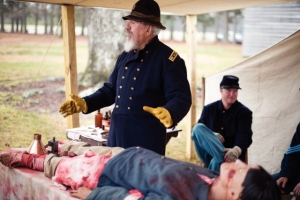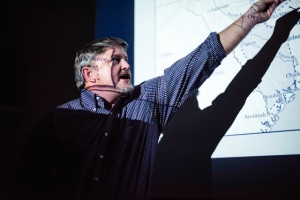Hospital tour: Bentonville re-created
By Steve Herring
Published in News on March 18, 2017 11:47 PM

News-Argus/SETH COMBS
Civil War living historian Rex Hovey speaks about conditions under which field surgeons would operate during the war at the Bentonville Battlefield Historic Site Saturday.

Wade Sokolosky
FOUR OAKS -- Gen. William Tecumseh Sherman's army engaged in four battles over a 12-day period in March 1865 as it marched toward Goldsboro, a strategic railroad crossroads.
Goldsboro escaped those bloody battles, but its four hospitals treated wounded from each.
The old Wayne County Courthouse served as a temporary hospital and the old Goldsboro Female College as the Confederacy's Hospital No. 3.
A wayside hospital was located near the railroad tracks close to the old Wayne County Fairgrounds.
The fourth hospital was a pest house hospital used to isolate and treat someone who might have mumps or measles. Its location is uncertain.
Confederate hospitals were the topic during a Saturday program as part of the "War so Terrible" observance of the 152nd anniversary of the Battle of Bentonville. The event will continue today from 10:30 a.m. to 5 p.m. at the Bentonville Battlefield State Historic Site at 5466 Harper House Road near Four Oaks.
It will include infantry and artillery demonstrations and simulated trauma scenarios.
Wade Sokolosky, a retired Army colonel, will make a presentation on Confederate hospitals at 11 a.m. and 2 p.m. He spoke Saturday to a crowd of Civil War buffs.
Sokolosky traces his interest in the Battle of Bentonville, Sherman's North Carolina Campaign and Confederate hospitals to his time as a young Army major stationed at Fort Bragg in 1995.The problem is there is no one source of information about the hospitals, he said. Instead it is scattered throughout a number of publications.
That set Sokolosky on a 15-year quest to compile the information, including period photos, letters and other documents for a book he plans to write.
A native of the Beaufort area in Carteret County, Sokolosky is a member of the Friends of the Bentonville Battlefield Association.
This month marks the 152nd anniversary of the largest and last of the big four battles in eastern North Carolina in March 1865, he said.
The four battles, fought over a 12-day period, overwhelmed Confederate medical facilities in the area, with troops being shipped as far west as Charlotte.
All of the activity in 1865 was because of one man, Sherman, who was making straight for Goldsboro as his army engaged in four battles over a 12-day period, Sokolosky said.
The first was the Battle of Wise's Forks near Kinston on March 8. The second, on March 10, was a big cavalry clash at Monroe's Crossroads near what is now Fort Bragg. The third was the Battle of Averasboro on March 16 and finally the Battle of Bentonville, the largest of the four, March 19-21.
There were four types of hospitals.
The first was a field hospital. A perfect example is Harper House that is located on the site, he said. The house was used by Union soldiers as a hospital.
"Primarily it is during the course of a battle that the surgeons are going to occupy a house obviously," he said. "The Harper House here was very convenient for the 14th Corps. A field hospital is temporary in nature.
"As soon as the battle is over with the patients are triaged. The dead are buried. The rest are put in wagons and ambulances, and they move on."
There were also wayside hospitals -- a concept born early on in 1862 when the war did not end as quickly as people had thought it would, he said.
It originated in Columbia, S.C., where women recognized that wounded soldiers were coming down South on furlough, he said.
The women developed the wayside concept where they could change bandages and assist the wounded or sick. The units were normally located near railroads because that is how soldiers traveled, Sokolosky said.
The South also had general hospitals similar to modern-day hospitals with a 300- to 400-bed capacity. Those hospitals had army surgeons assigned to them by the Confederate medical department.
There were 14 in North Carolina, including in Goldsboro, by 1865, Sokolosky said.
The fourth type was a temporary hospital, established in an effort to deal with the massive amount of casualties.
"You will notice a pattern here," he said. "The medical department liked to take over female schools. They made excellent multi-story, lots of rooms and stuff, conveniently located along the railroad."
General Hospital No. 3 was located in Goldsboro in the old Goldsboro Female College.
"Later in the 1900s we are talking this is the old Goldsboro High School," he said. "It has been torn down now of course. But you see the pattern here -- multi-story rooms, lots of rooms. From early 1862 all the way to right after the Battle of Wise's Forks and before the Battle of Bentonville, this hospital right here, No. 3 is basically shut down, moved and re-established almost all the way out to High Point.
"We know a lot about this hospital because of this wonderful lady here, nurse Kate Sperry. She is actually from Winchester, Va."
Her mother died early in the war, and she had a number of brothers serving in the Confederacy, Sokolosky said.
Within the space of a week Winchester went from the Confederacy to Union control, he said.
Her father sent her to live with an aunt in Goldsboro, not realizing Sherman would march through the area in March 1865.
"But she does marry one of the doctors here at No. 3, and she keeps a wonderful diary," Sokolosky said. "It is a treasure trove of information. She literally pens the day, she said, 'I showed up at work on the morning of March 11th and my old man (her husband) said to pack up.' Her diary literally stops on March 11th."
It picks back up on March 19 in High Point, an indication it took about a week to move from Goldsboro to High Point, he said.
